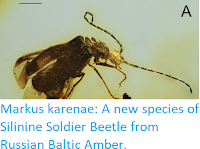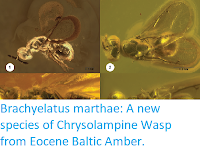The term 'Aphidlion' refers to the larvae of some Neuropteran Insects (Lacewings) which are specialised for hunting Aphids. They are related to Antlions, which are also the larvae of Neuropteran Insects, and which hunt Ants, but unlike Antlions, which are ambush specialists, they are free-ranging raptorial predators which actively hunt down their prey. The term Aphidlion is applied to the larvae of two different Neuropteran groups, the Green Lacewings, Chrysopidae, and the Brown Lacewings, Hemerobiidae, which were one thought to be sister groups but are currently thought to be only distantly related within the Neuroptera as a whole (it is also sometimes used for the larvae of Ladybird Beetles, which also feed on Aphids, but this usage for a very different group is confusing, and best avoided).
Like other Lacewing larvae, Aphidlions are voracious predators with highly specialised feeding apparatus, with the upper and lower jaws fused to form a pair of feeding stylets, which are used to first inject their prey with venom, then digestive juices, and finally to suck out the prey's dissolved tissues. The stylets of Aphidlions tend to be simple and curved, unlike those of Antlions, which bear teeth, or the larvae of Mantis, Bearded, and Lance Lacewings, which have straight stylets. In addition, the body of Aphidlions is rather spindle-shaped compared to other Lacewing larvae.
Their ability to consume large numbers of Aphids in a relatively short period of time makes Aphidlions an important part of modern ecosystems, and has made them attractive to farmers and horticulturalists as a biological means of controlling Aphid populations, with several species used in this way. Aphidlions are also known in the fossil record, as inclusions in Cretaceous and Eocene ambers, although they are not as numerous as adult Lacewings. Based upon the morphology of these fossil Aphidlions, it is assumed that their ecological role is as ancient as the group (Neuropteran Insects formed a major part of Mesozoic ecosystms, ans were formerly far more numerous and diverse than they are today), although this is very hard to prove from isolated individuals.
In a paper published in the journal Palaeobiodiversity and Palaeoenvironments on 25 January 2022, Joachim Haug of the Biocenter and GeoBio-Center at Ludwig-Maximilians-Universität München, Christine Kiesmüller of Cytology and Evolutionary Biology at the University of Greifswald, Gideon Haug, also of the Biocenter at Ludwig-Maximilians-Universität München, Carolin Haug, again of the Biocenter and GeoBio-Center at Ludwig-Maximilians-Universität München, and Marie Hörnig, also of Cytology and Evolutionary Biology at the University of Greifswald, report the discovery of an Aphidlion along with several Aphids in a single piece of Eocene Baltic Amber, strongly supporting the idea that the ecological association between these groups existed by this time.
The amber used in the study was purchased from a dealer, Jonas Damzen, of Vilnius, Lithuania, and now resides in the Palaeo-Evo-Devo Research Group Collection of Arthropods at Ludwig-Maximilians-University of Munich. Baltic ambers predominantly come from the Blue-Earth Formation of Russia's Kaliningrad Peninsula. The age of Baltic Amber is not completely resolved, but most palaeontologists believe it to be of Late Eocene origin, making it between 38 and 34 million years old.
The amber piece described by Haug et al. contains a number of inclusions, including several Insect exuviae (shed skins), all to deformed to be identified, a large elongate Insect, which Haug et al. identify as an Aphidlion, and three smaller Insects with prominent Hemipteran-type beaks, which Haug et al. identify as Aphids.
Many details on the larger Insect are concealed, but it is elongate, with a distinct head and body, and the head bears three sets of paired structures, iterpreted as antennae, stylets and labial palps. The antennae are elongate and split into three sections, a short wide base, a long, narrow middle section and an tapering tip. The stylets are simple and curved, lacking any teeth, as would be predicted for an Aphidlion. The labial palps have two distinct elements, with the proximal (base) element being obscured and the distal element being club shaped.
This specimen is too obscured to be identified to species level, but can be identified as an Aphidlion based upon its short antennae, prominent labial palps, and sickle-shaped mandibles. These traits are also found in some Beetle larvae, but these would be expected to have some other features, such as paired maxillary palps, which are absent in the specimen. The general morphology of both the specimen's body and it's appendages also match that of the Aphidlion-larvae of a Brown Lacewing, Hemerobiidae.
The three Aphids are roughly similar in form, but differ in size, with the largest specimen being about 1 mm in length, and the other two only 0.6 mm. The bodies of these specimens are differentiated into heads and trunks, with the heads wider than they are long, and partly covered by the forward part of the trunk. They have prominent antennae protruding antero-laterally from the head, and mouth parts modified to form an elongate beak. The front three segments of the trunk are prominent, each being longer than the head and supporting a pair of 'z' shaped legs. The segments of the posterior part of the trunk are less clearly defined, but there appear to be 9-10, terminating with a compound structure of several segments.
The similar appearance of the three Aphid specimens suggests that they belong to the same species, with the larger specimen probably being a later instar (developmental stage separated by a moult) than the two smaller specimens. Aphids are very common in Baltic Amber, although it is difficult to differentiate the long winged developmental stages to species level. Based upon the general form of these specimens, Haug et al. suggest that they might belong to the genus Germaraphis.
The amber piece appears to contain the Aphidlion-larvae of a Brown Lacewing, a group which today specialise in predating soft-bodied prey, particularly Aphids. Brown Lacewings are common in the fossil record, and are often found in environments which also support aphids, and preserved larvae are much less common than adults (excluding specimens preserved in amber, most Lacewing fossils are isolated wings, which the larvae lack), and a direct association between these Insects and Aphids in the pasr has been hard to prove. The specimen examined by Haug et al. shows the co-existence of a Brown Lacewing Aphidlion and several Aphids, showing that they were present in the same environment, and therefore that a predator-prey relationship was highly likely, at least as far back as the Eocene.
See also...



Online courses in Palaeontology.
Follow Sciency Thoughts on Facebook.
Follow Sciency Thoughts on Twitter.





